'Complete and Balanced' and Raw Food - a Square Peg in a Round Hole?

by Narelle Cooke, Canine Nutritionist
You may or may not have heard of the Association of American Feed Control Officials (AAFCO) - it’s the primary body that sets the labelling, ingredient and nutritional standards for pet foods in the United States. Which may have you questioning – how is that relevant to me and my dog? Well, while AAFCO is an American organisation, many pet foods sold in Australia are imported from overseas and many Australia pet food manufacturers follow the AAFCO guidelines, as permitted in the Australian Standard for the Manufacturing and Marketing of Pet Food (1). So when you buy dog food that claims to be nutritionally “complete and balanced”, it indicates that the food meets the AAFCO standards. But what does the term ‘complete and balanced’ actually mean?
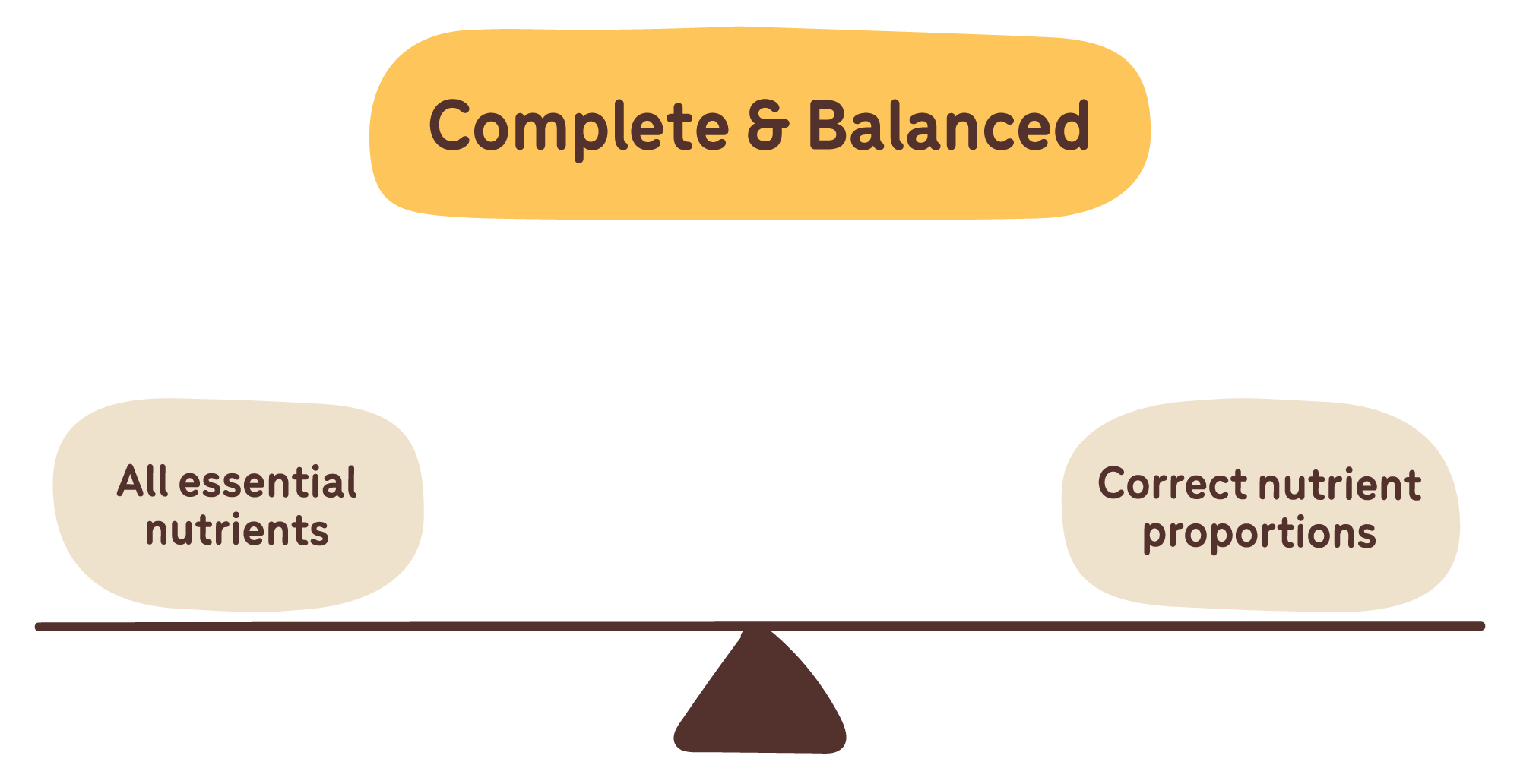
‘Complete’ means a food should contain all nutrients that AAFCO classifies as essential for a dog, while ‘balanced’ means that the food should contain those nutrients in the correct proportions as determined by AAFCO. And while seeing the claim ‘complete and balanced’ on a label gives most pet parents peace of mind that their pet is getting everything they need from a nutritional standpoint - it’s certainly not a guarantee of nutritional adequacy (2-5), not to mention that countless commercial kibbles and canned foods – even supposed “higher quality” formulas – have been found to contain undeclared ingredients (6-10), and unacceptable levels of mycotoxins (11-14), euthanasia drugs (15,16), and other contaminants (17), resulting in significant health concerns and even death.
One of the main aims of AAFCO is to ensure that pet foods are nutritionally safe and to do this, they have outlined minimum and some maximum nutrient levels that manufacturers need to adhere to. However, significant concerns have been raised regarding the validity and accuracy of these values because no-one – not even AAFCO itself, really know what the biologically optimum levels of the different nutrients are for our pets, hence, the information is always changing.
To give an example: The safe upper limit for iron in dogs was originally based on studies in pigs! In setting the current recommended allowance of iron for adult maintenance, the apparent digestibility of iron was considered to be 20%. However, the digestibility of iron in the scientific literature has ranged from close to 100% to less than 10% and is affected by numerous factors such as the specific source of iron, the concentration of other specific minerals or other ingredients in the diet, as well as the iron status of the animal. In addition, some sources of iron are considered unavailable and are used for colouring the product and not for nutrient value, yet such unavailable sources will still contribute iron to the results of a chemical analysis in the support of a ‘complete and balanced’ claim (more on what this means shortly) (18).
Even AAFCO acknowledge that “the specific example for iron can be generalised to most essential minerals and demonstrates the impossibility that any list of concentrations can invariably ensure that all nutrient requirements are fulfilled in all diet formulas without additional considerations (18).”
The other aspect to consider when it comes to formal nutrient guidelines is that such tables are very often not accurate representations of reality. A paper reviewing the nutritional adequacy of pet foods through the life cycle stated that “there is no such thing as a single nutrient requirement for an animal but rather families of requirements for each nutrient that depend on the physiological state of the animal and the metabolic function that is either to be met or to be optimized (19).”
Now let’s look at the two main ways that pet food manufacturers can meet the AAFCO standard of ‘complete and balanced’.
1- Chemical analysis

Pet food manufacturers can choose to formulate their food to meet the AAFCO (the American standard) or FEDIAF (the European standard) nutritional guidelines and then demonstrate adherence to the required nutrient levels by subjecting the food to a chemical analysis. This is where a sample of the formulated food is sent to a laboratory and, by using high-tech equipment, they are able to determine the chemical composition of the food, such as the levels of each of the essential amino acids, vitamins and minerals, to see if they match what AAFCO require.
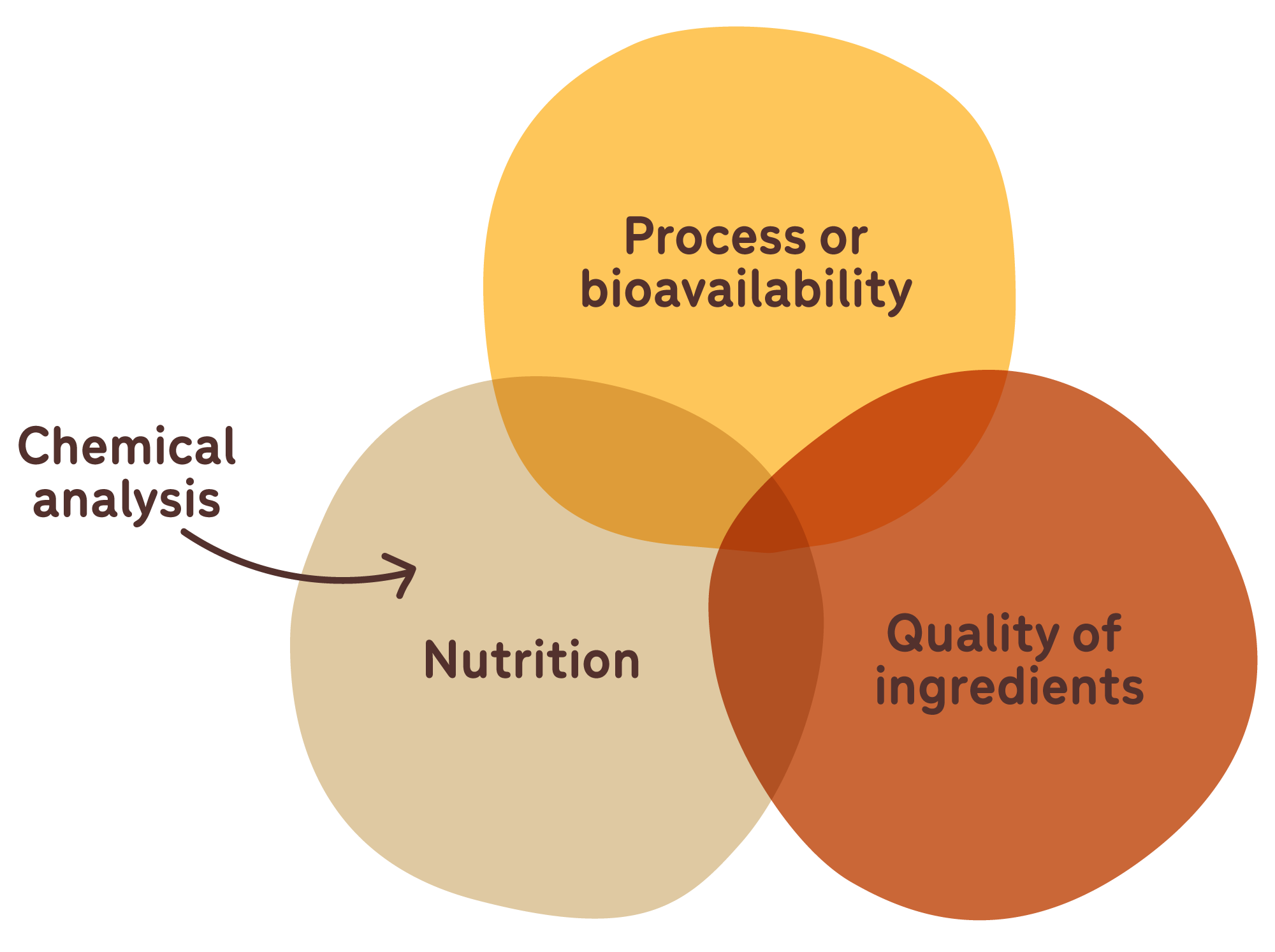
However, according to an earlier version of the National Research Council’s (NRC) extensive text on ‘The Nutrient Requirements of Dogs’, they state: “caution is advised in the use of these requirements without demonstration of nutrient availability, because in some cases requirements have been established on the basis of studies in which nutrients were supplied by highly purified ingredients where digestibility and availability were not compromised by the interaction of dietary constituents and effects of processing. Practical diets formulated from commonly used ingredients are not free of such interactions and effects, and therefore may provide less available nutrients than the amounts measured by chemical analysis. For this reason, such diets formulated to the chemically assayed nutrient levels...may prove inadequate in meeting the nutritional needs of dogs. […] Therefore, users are advised to obtain evidence of nutritional adequacy by direct feeding to dogs (20).”
In addition to the concerns raised by the NRC, another red flag with the chemical analysis method is that the results only need to demonstrate that the food doesn’t exceed set maximums for a small number of nutrients (21). However, because synthetic vitamin and mineral premixes need to be added back into the food in order for it to be nutritionally adequate, this has the potential to go very wrong, and can result in recalls due to toxicity and death (4).
Another negative aspect of the chemical analysis method is that it doesn’t take into account the quality of the ingredients used. For example, protein in a pet food could come from high quality human-grade meat, or from much poorer quality sources such as road-kill, soy meal, corn gluten meal or even a toxic substance such as melamine, as occurred in 2007, which resulted in the death of thousands of dogs. Unfortunately, the reason that melamine was included in the food in the first place was to boost the protein content as determined by chemical analysis (22)!
2 – Via a feeding trial
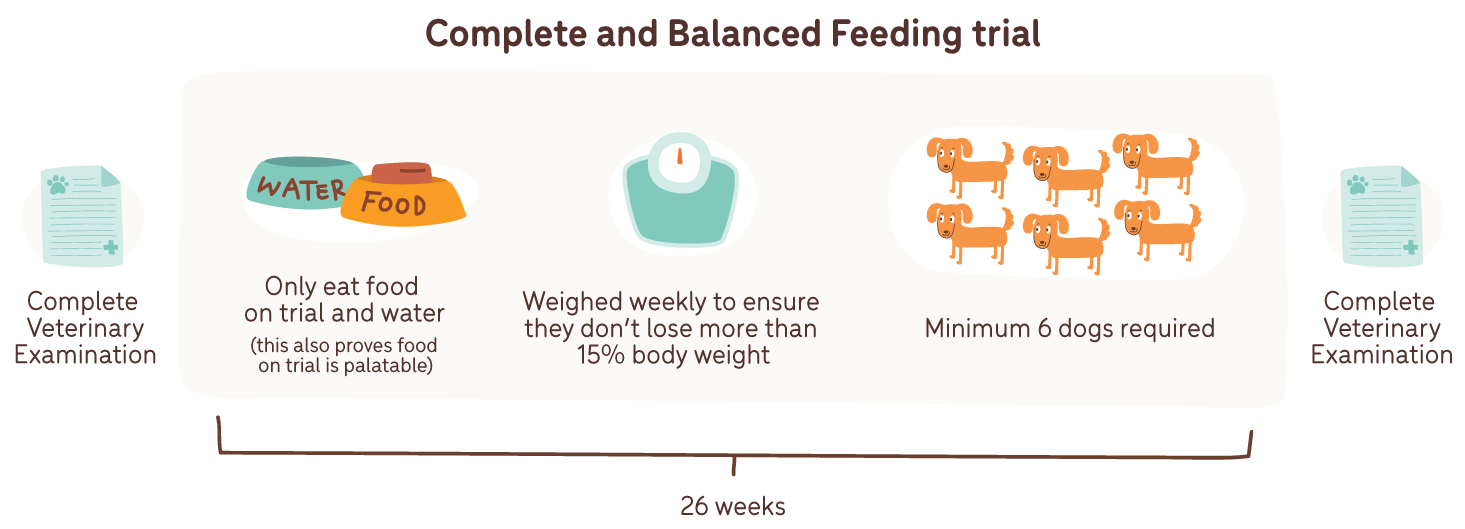
The second method that pet food manufacturers can use to gain the ‘complete and balanced’ claim is by conducting a feeding trial (which has been considered the gold standard) (19), whereby the food in question is the only source of nutrition provided other than water. One of the key benefits of the feeding trial method is that it demonstrates that the food is palatable to the dogs and that they actually want to eat it. Feeding trials also involve the dogs undergoing a complete veterinary examination at the beginning and end of the trial, which includes blood test being taken to measure four key parameters (haemoglobin, packed cell volume, alkaline phosphatase, albumin), and the dogs are weighed weekly to ensure that they don’t lose more than 15% of their body weight. The downside is that only a small number of dogs are required to complete the trial (6), and the trial only runs for a short period of time (26 weeks for adult maintenance).
What does all of this mean for raw food feeding?
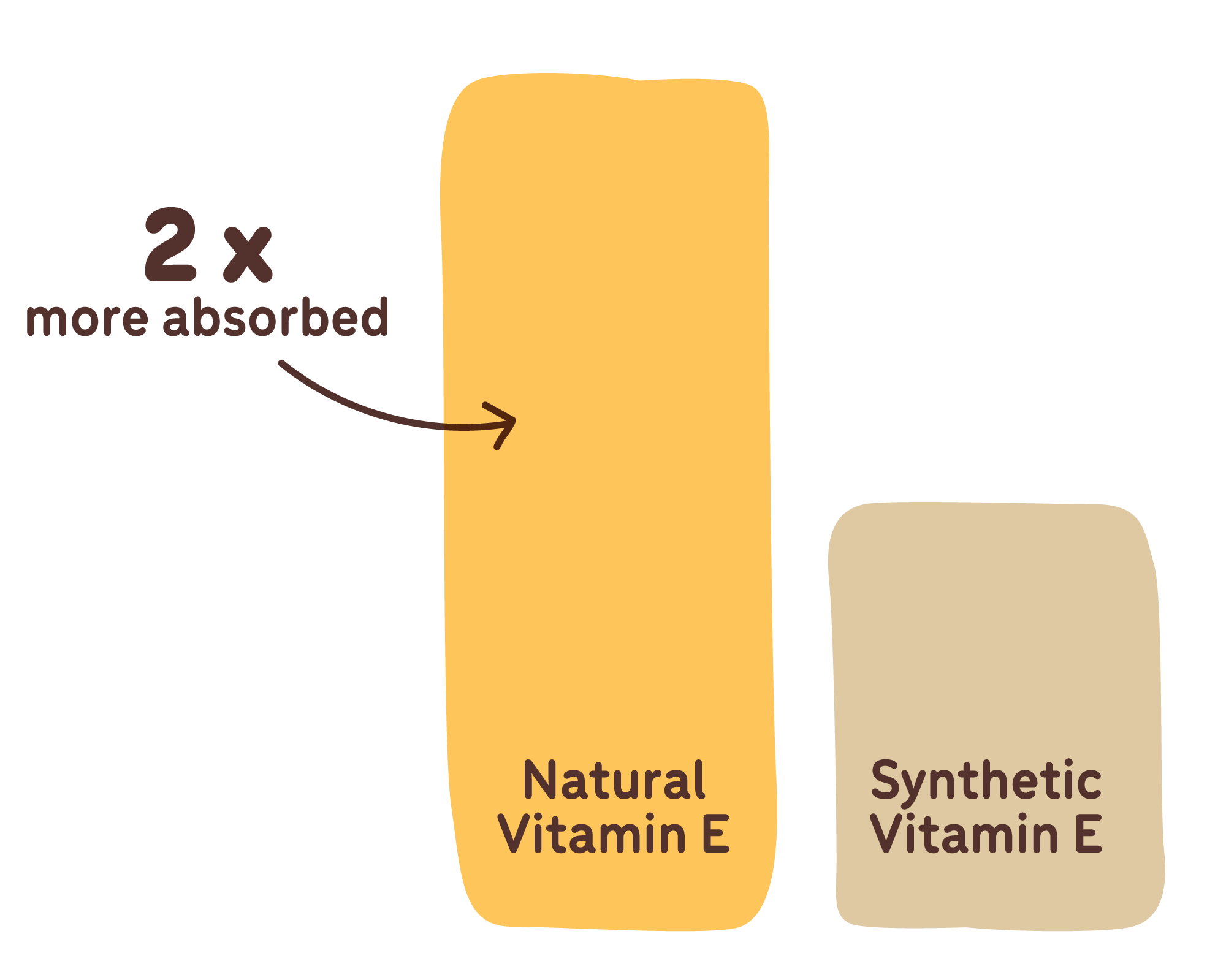
The AAFCO nutrient guidelines were primarily developed for use with highly processed commercial products such as kibbles and canned foods that require the addition of synthetic nutrients back into the food to ensure that they meet nutritional adequacy. However, we know that naturally occurring vitamins and minerals, such as found in fresh whole foods, have very different and often much more complex molecular structures as compared to their synthetic equivalents. And despite their widespread use, it’s still unclear how well synthetic nutrients are absorbed and used in the body (for both us and our pets). This is because when our pets eat real whole foods, they’re consuming a wide range of different vitamins, minerals, and enzymes that allow for optimal use by the body. Without these additional compounds, synthetic nutrients are unlikely to be used by the body in the same way as their natural counterparts (23). For example, studies show that in humans, natural vitamin E is absorbed twice as efficiently as synthetic vitamin E (24), and in different animal models, vitamin C uptake was enhanced when obtained from a natural source as compared to a synthetic source (25).
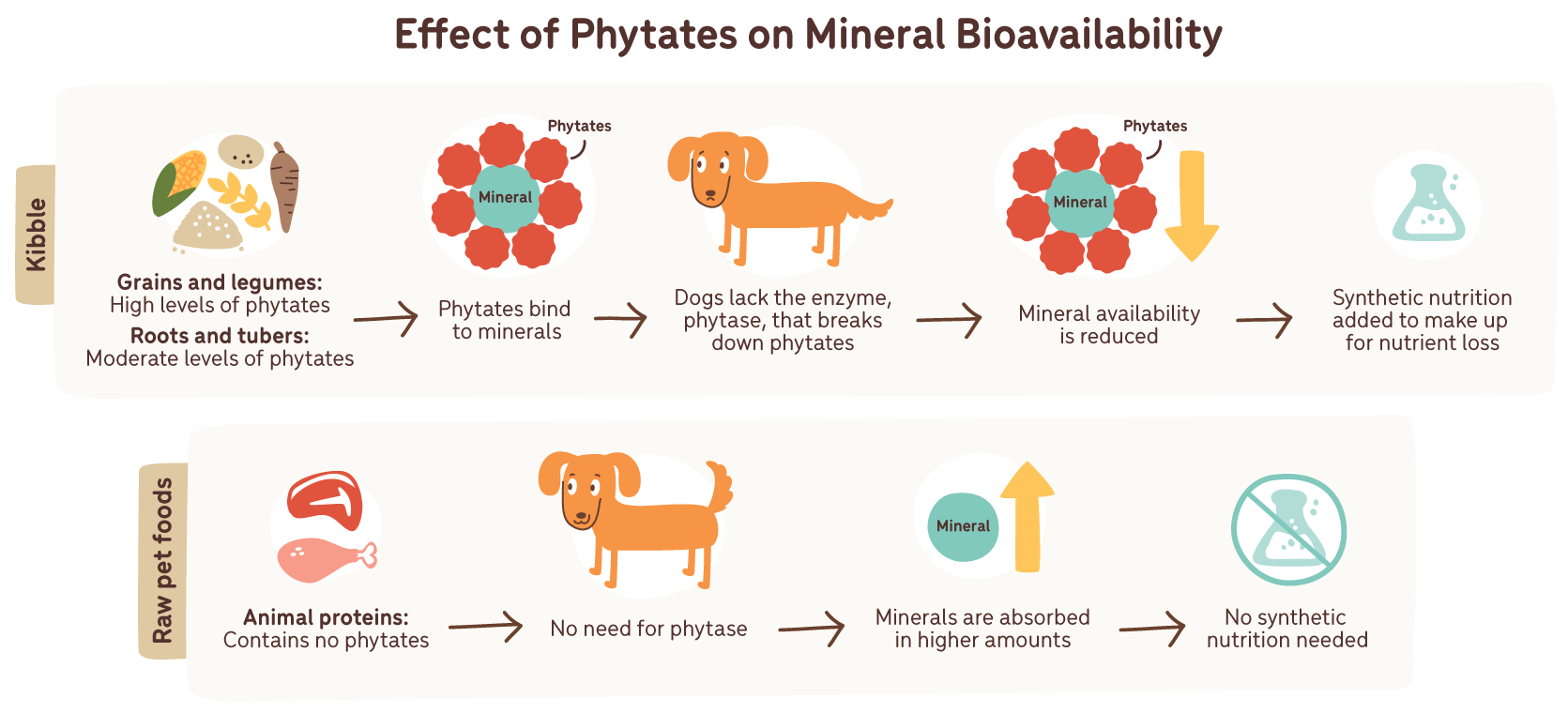
Coming back to the AAFCO guidelines, given the increased bioavailability of nutrients from fresh whole foods, if raw pet food manufacturers are required to meet the same standards as kibble, our pets may end up consuming much higher levels of nutrients than they require, which could cause more harm than good. A well-known example of this can be seen with the mineral zinc.
Zinc is known to have low bioavailability in commercial kibble due to the presence of anti-nutritional factors, such as phytates. Phytates are natural compounds found in many plant-based foods, with particularly high levels present in grains and legumes (i.e. wheat, corn, rice and soy), with lesser amounts found in roots and tubers (i.e. potatoes, taro and cassava(tapioca)). Phytates bind strongly to minerals such as zinc, iron, manganese and calcium, and because our dogs lack the enzyme phytase in their digestive tract to break down the phytates, the minerals that they bind to become unavailable to the dog. What this means from a practical perspective is that higher amounts of synthetic zinc need to be added to kibbles to ensure that an animal is still meeting the minimum requirements. Animal proteins contain no phytates, which means that a dog consuming a more species-appropriate whole food diet based largely on muscle meats, organ meats and bone, will be getting much higher amounts of zinc naturally.
A similar situation exists in human nutrition, whereby many world health organisation’s state that vegetarians, particularly vegans, need zinc intakes that are approximately 50% higher than non-vegetarians/vegans, due to the negative impact that phytates have on zinc bioavailability. Phytate-associated deficiencies of the minerals iron and zinc are also commonly known to occur in third-world countries where people mostly eat grains (26).
If we assume that zinc from a primarily meat-based diet is around 50% bioavailable and zinc from a diet high in grains and legumes (as is found in many commercial kibbles) is around 20% bioavailable (27), and that the AAFCO guidelines state a minimum requirement of 20 mg of zinc (per 1,000 kcal) (21). The commercial kibble would need to contain 100 mg of zinc in order to provide 20 mg to the dog (20% bioavailable), whereas a meat-based diet would only need to contain 40 mg of zinc to start with, in order to provide 20 mg to the dog (50% bioavailable). However, if the raw food was held to the same standard for zinc as the commercial kibble, which is based on a reduced bioavailability of only 20%, and additional synthetic zinc was added to make up for the perceived discrepancy, then our dogs would be consuming excessive amounts of zinc that would likely lead to negative health effects over time.
So, as you can see – it’s complicated! But at the end of the day, what’s important to remember is that the AAFCO nutrient profiles have been established to try and make up for the loss of vitamins, minerals and amino acids due to anti-nutrient factors and extensive processing that occurs in kibbles and canned foods, whereas raw foods don’t contain detrimental anti-nutritional factors and they don’t undergo the same heat-treatment and processing. So, while the AAFCO standards do have a role to play in protecting our pets from nutritional imbalances, deficiencies and excesses, when it comes to raw food feeding, they may not be the best fit – a square peg in a round hole, so to speak! In considering what would be in the best interests of our pets, I think a better approach would be to have two different nutritional standards in place – one for processed foods and one for raw foods. Unfortunately, we’re not there yet.
About the Author - Narelle Cooke, Canine Nutritionist.

Narelle is a clinical Naturopath, Nutritionist and Herbalist for both people and pets, and operates her wellness clinic ‘Natural Health and Nutrition’ in Dural, Sydney.
Being a lifelong dog-owner and currently meeting the demands of three French Bulldogs, two German Shepherds and a Burmese cat, Narelle is as passionate about the health and wellbeing of our pets as she is about their owners. And it was this strong desire to see her own pets live their longest and best lives that led her to hours of personal research and additional study in the area of natural animal health and nutrition.
· Bachelor of Health Science(Naturopathy) (ACNT)
· Bachelor of Agricultural Science (honours) (The University of Melbourne)
· Advanced Diploma of Naturopathy (AIAS)
· Advanced Diploma of Nutritional Medicine (AIAS)
· Advanced Diploma of Western Herbal Medicine (AIAS)
· Certificate III in Dog Behaviour and Training (NDTF)
· Certificate in Natural Animal Nutrition (CIVT)
· Certificate in Animal Nutrition (HATO)
